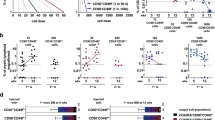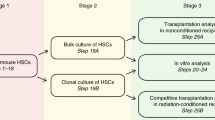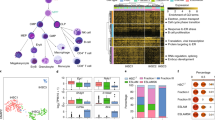Abstract
Elucidation of the identity and diversity of mechanisms that sustain long-term human blood cell production remains an important challenge. Previous studies indicate that, in adult mice, this property is vested in cells identified uniquely by their ability to clonally regenerate detectable, albeit highly variable levels and types, of mature blood cells in serially transplanted recipients. From a multi-parameter analysis of the molecular features of very primitive human cord blood cells that display long-term cell outputs in vitro and in immunodeficient mice, we identified a prospectively separable CD33+CD34+CD38−CD45RA−CD90+CD49f+ phenotype with serially transplantable, but diverse, cell output profiles. Single-cell measurements of the mitogenic response, and the transcriptional, DNA methylation and 40-protein content of this and closely related phenotypes revealed subtle but consistent differences both within and between each subset. These results suggest that multiple regulatory mechanisms combine to maintain different cell output activities of human blood cell precursors with high regenerative potential.
This is a preview of subscription content, access via your institution
Access options
Access Nature and 54 other Nature Portfolio journals
Get Nature+, our best-value online-access subscription
$29.99 / 30 days
cancel any time
Subscribe to this journal
Receive 12 print issues and online access
$209.00 per year
only $17.42 per issue
Buy this article
- Purchase on Springer Link
- Instant access to full article PDF
Prices may be subject to local taxes which are calculated during checkout







Similar content being viewed by others
References
Till, J. E. & McCulloch, E. A. A direct measurement of the radiation sensitivity of normal mouse bone marrow cells. Radiat. Res. 14, 213–222 (1961).
Becker, A. J., McCulloch, E. A. & Till, J. E. Cytological demonstration of the clonal nature of spleen colonies derived from transplanted mouse marrow cells. Nature 197, 452–454 (1963).
Appelbaum, F. R., Forman, S. J., Negrin, R. S. & Blume, K. G. Thomas’ Hematopoietic Cell Transplantation (John Wiley & Sons, Hoboken, NJ, 2011).
Copley, M. R., Beer, P. A. & Eaves, C. J. Hematopoietic stem cell heterogeneity takes center stage. Cell Stem Cell 10, 690–697 (2012).
Eaves, C. J. Hematopoietic stem cells: concepts, definitions, and the new reality. Blood 125, 2605–2613 (2015).
Yu, V. W. C. et al. Epigenetic memory underlies cell-autonomous heterogeneous behavior of hematopoietic stem cells. Cell 167, 1310–1322 (2016).
Pietras, E. M. et al. Chronic interleukin-1 exposure drives haematopoietic stem cells towards precocious myeloid differentiation at the expense of self-renewal. Nat. Cell Biol. 18, 607–618 (2016).
Wohrer, S. et al. Distinct stromal cell factor combinations can Separately control hematopoietic stem cell survival, proliferation, and self-renewal. Cell Rep. 7, 1956–1967 (2014).
Rieger, M. A., Hoppe, P. S., Smejkal, B. M., Eitelhuber, A. C. & Schroeder, T. Hematopoietic cytokines can instruct lineage choice. Science 325, 217–218 (2009).
Biasco, L. et al. In vivo tracking of human hematopoiesis reveals patterns of clonal dynamics during early and steady-state reconstitution phases. Cell Stem Cell 19, 107–119 (2016).
Aiuti, A. et al. Lentiviral hematopoietic stem cell gene therapy in patients with Wiskott–Aldrich syndrome. Science 341, 1233151 (2013).
Biffi, A. et al. Lentiviral hematopoietic stem cell gene therapy benefits metachromatic leukodystrophy. Science 341, 1233158 (2013).
Kim, S. et al. Dynamics of HSPC repopulation in non-human primates revealed by a decade-long clonal-tracking study. Cell Stem Cell 14, 473–485 (2014).
Cheung, A. M. S. et al. Analysis of the clonal growth and differentiation dynamics of primitive barcoded human cord blood cells in NSG mice. Blood 122, 3129–3137 (2013).
Velten, L. et al. Human haematopoietic stem cell lineage commitment is a continuous process. Nat. Cell Biol. 19, 271–281 (2017).
Wilson, N. K. et al. Combined single-cell functional and gene expression analysis resolves heterogeneity within stem cell populations. Cell Stem Cell 16, 712–724 (2015).
Notta, F. et al. Isolation of single human hematopoietic stem cells capable of long-term multilineage engraftment. Science 333, 218–221 (2011).
Knapp, D. J. H. F. et al. Dissociation of survival, proliferation, and state control in human hematopoietic stem cells. Stem Cell Rep. 8, 152–162 (2017).
Nguyen, L. V. et al. Clonal analysis via barcoding reveals diverse growth and differentiation of transplanted mouse and human mammary stem cells. Cell Stem Cell 14, 253–263 (2014).
Miller, P. H. et al. Analysis of parameters that affect human hematopoietic cell outputs in mutant c-kit-immunodeficient mice. Exp. Hematol. 48, 41–49 (2017).
Yano, M. et al. Expression and function of murine receptor tyrosine kinases, TIE and TEK, in hematopoietic stem cells. Blood 89, 4317–4326 (1997).
Busch, K. et al. Fundamental properties of unperturbed haematopoiesis from stem cells in vivo. Nature 518, 542–546 (2015).
Laurenti, E. et al. CDK6 levels regulate quiescence exit in human hematopoietic stem cells. Cell Stem Cell 16, 302–313 (2015).
Farlik, M. et al. Single-cell DNA methylome sequencing and bioinformatic inference of epigenomic cell-state dynamics. Cell Rep. 10, 1386–1397 (2015).
Smallwood, S. A. et al. Single-cell genome-wide bisulfite sequencing for assessing epigenetic heterogeneity. Nat. Methods 11, 817–820 (2014).
Luo, C. et al. Single-cell methylomes identify neuronal subtypes and regulatory elements in mammalian cortex. Science 357, 600–604 (2017).
Pellacani, D. et al. Analysis of normal human mammary epigenomes reveals cell-specific active enhancer states and associated transcription factor networks. Cell Rep. 17, 2060–2074 (2016).
Taussig, D. C. et al. Hematopoietic stem cells express multiple myeloid markers: implications for the origin and targeted therapy of acute myeloid leukemia. Blood 106, 4086–4092 (2005).
Walter, R. B., Appelbaum, F. R., Estey, E. H. & Bernstein, I. D. Acute myeloid leukemia stem cells and CD33-targeted immunotherapy. Blood 119, 6198–6208 (2012).
Thol, F. & Schlenk, R. F. Gemtuzumab ozogamicin in acute myeloid leukemia revisited. Expert Opin. Biol. Ther. 14, 1185–1195 (2014).
Sirin, O., Lukov, G. L., Mao, R., Conneely, O. M. & Goodell, M. A. The orphan nuclear receptor Nurr1 restricts the proliferation of haematopoietic stem cells. Nat. Cell Biol. 12, 1213–1219 (2010).
Volakakis, N. et al. NR4A orphan nuclear receptors as mediators of CREB-dependent neuroprotection. Proc. Natl Acad. Sci. USA 107, 12317–12322 (2010).
Knapp, D. J. H. F. et al. Distinct signaling programs control human hematopoietic stem cell survival and proliferation. Blood 129, 307–318 (2017).
Sanjuan-Pla, A. et al. Platelet-biased stem cells reside at the apex of the haematopoietic stem-cell hierarchy. Nature 502, 232–236 (2013).
Yamamoto, R. et al. Clonal analysis unveils self-renewing lineage-restricted progenitors generated directly from hematopoietic stem cells. Cell 154, 1112–1126 (2013).
van Galen, P. et al. Reduced lymphoid lineage priming promotes human hematopoietic stem cell expansion. Cell Stem Cell 14, 94–106 (2014).
Hashimshony, T. et al. CEL-Seq2: sensitive highly-multiplexed single-cell RNA-Seq. Genome Biol. 17, 77 (2016).
Beer, P. A. et al. A dominant-negative isoform of IKAROS expands primitive normal human hematopoietic cells. Stem Cell Rep. 3, 841–857 (2014).
Fares, I. et al. Pyrimidoindole derivatives are agonists of human hematopoietic stem cell self-renewal. Science 345, 1509–1512 (2014).
Hashimshony, T. et al. CEL-Seq2: sensitive highly-multiplexed single-cell RNA-Seq. Genome Biol. 17, 77 (2016).
Hui, T., Cao, Q., Moksa, M., & Hirst, M. Post-bisulfite adapter ligation (PBAL) library construction for single cells. Protoc. Exch. https://doi.org/10.1038/protex.2018.052 (2018).
Lorzadeh, A. et al. Nucleosome density ChIP-Seq identifies distinct chromatin modification signatures associated with MNase accessibility. Cell Rep. 17, 2112–2124 (2016).
Zunder, E. R. et al. Palladium-based mass tag cell barcoding with a doublet-filtering scheme and single-cell deconvolution algorithm. Nat. Protoc. 10, 316–333 (2015).
Van der Maaten, L. & Hinton, G. Visualizing data using t-SNE. J. Mach. Learn. Res. 9, 85 (2008).
Grossmann, S., Bauer, S., Robinson, P. N. & Vingron, M. Improved detection of overrepresentation of Gene-Ontology annotations with parent–child analysis. Bioinformatics 23, 3024–3031 (2007).
Boeva, V. et al. Control-FREEC: a tool for assessing copy number and allelic content using next-generation sequencing data. Bioinformatics 28, 423–425 (2012).
Hansen, K. D., Langmead, B. & Irizarry, R. A. BSmooth: from whole genome bisulfite sequencing reads to differentially methylated regions. Genome Biol. 13, R83 (2012).
Acknowledgements
The authors thank M. Hale, G. Edin and the British Columbia Cancer Agency Stem Cell Assay Laboratory staff for technical assistance including the initial processing of CB samples. This work was supported by a Terry Fox Foundation New Frontiers Program Project, a Stem Cell Network of Centres of Excellence grant and grants from the Canadian Institutes of Health Research (CIHR). D.J.H.F.K. held a CIHR Vanier Scholarship. C.A.H. and P.H.M. held a CIHR Frederick Banting and Charles Best Doctoral Scholarship. DVS Sciences provided the Palladium barcoding reagents used in the mass cytometry experiments.
Author information
Authors and Affiliations
Contributions
D.J.H.F.K. and C.J.E. designed the experiments and wrote the manuscript. D.J.H.F.K. and C.A.H. performed all of the cell sorting, mass cytometry and biological experiments. T.H. and M.H. performed the PBAL methylome sequencing and related analysis. M.T.J.v.L and C.H. performed Cel-Seq2 and preliminary analysis of that data. D.J.H.F.K. performed all of the final data analyses. P.H.M., P.A.B., R.K.H. and C.H. assisted with experimental designs and interpretation. F.W. assisted with in vitro experiments. N.A. and D.P. helped with data analysis and interpretation. G.M.R. assisted with mouse analyses. M.M. and M.H. performed the lentiviral sequencing and assisted with data processing. All authors read and approved the final manuscript.
Corresponding author
Ethics declarations
Competing interests
The authors declare no competing interests.
Additional information
Publisher’s note: Springer Nature remains neutral with regard to jurisdictional claims in published maps and institutional affiliations.
Integrated supplementary information
Supplementary Figure 1 Data normalization for cross-platform comparison of flow and mass cytometric data.
(a) Gating hierarchy for cells in the CD49f CB population using mass cytometry. (b) Raw data (left) from 3 independent index sort FACS experiments are shown in blue, magenta and aquamarine, and from mass cytometry experiments in grey. Rank-normalized data (used for determining nearest-neighbours for sorted cells in the mass cytometry data) are shown in the middle panels. The right panels show mean-scaled data (channel z-score) for the flow cytometry data only (used in surface marker comparisons between experiments).
Supplementary Figure 2 Additional marker intensities of the nearest neighbours of index-sorted 49f CB cells with different proliferative activities in LTC.
All surface (a) and intracellular (b) markers that were not in the top 5 are shown here (See Figure 2d for the top 5 marks and 2e for exact p values determined using the Kruskal-Wallis rank sum test, n=1,614 nearest neighbours in total). Differences that did not reach significance are marked with "NS". Lines indicate median values. Values represent asinh(marker intensity/5).
Supplementary Figure 3 Logistic regression classifier guided gating for 49f CB cells that are highly proliferative in LTC.
(a) A receiver-operator curve for a logistic regression classifier trained to detect 49f CB cells with high proliferative potential is shown (created using the R library ‘ROCR’). Classifier variables were selected using a step-wise procedure to minimize information loss while minimizing the number of markers (using the R function ‘step’). (b) Threshold selection based on the F-measure (harmonic mean of precision and recall). A red point indicates the selected threshold. (c) Plot coordinates of all analyzed 49f CB cells over all combinations of the 3 markers (CD34, CD90, and CD10) included in the final model. Marker values represent the mean-scaled fluorescence values (channel Z-score). Colour coding indicates proliferative capacity as in Figure 2 (n=538). Blue circles indicate cells selected based on the logistic regression model. (d) Mean-scaled surface marker intensities for each input cell from the barcode tracking experiments (n=61) are plotted as a function of the total number of cells it produced at the time of sacrifice of the primary mice. Colour coding of clone lineage composition is indicated in the key in Figure 4. (e) PCA performed based on surface marker intensities (mean-scaled) with point sizes proportional to corresponding clone sizes. (f) Mapping of the barcoded clones to the t-SNE mass cytometric distribution for the 49f CB compartment. As in Figure 2c, nearest neighbours for all members of a given initial cell type were pooled and used to generate a probability density, indicated by colour intensity. The lowest level contains 95% of the total probability density with levels at each 10% mark thereafter. Point estimates for each input cell represent the median t-SNE value of their nearest neighbours in each t-SNE dimension. Point size is shown as proportional to the size of the clone it identifies assessed at the 30+ week post-transplant time of sacrifice of the primary mice. A contour showing the boundary containing 50% of the probability density of the highly proliferative input cells detected in the LTC assays (Figure 2c) is shown in black.
Supplementary Figure 4 Gating hierarchies of subsets within the 49f CB population.
FACS gating hierarchies are shown for experiment 1 (a) and 2 (b), respectively. Gates based on mass cytometric data are shown in (c).
Supplementary Figure 5 Additional marker intensities within the CD33 subsets of 49f CB cells.
All surface (a) or intracellular (b) markers that were not in the top 5 are shown here. See Figure 5b for exact p values (n=2713 cells total). Top 5 marks are shown in Figure 4. Differences that did not reach significance (Holm-corrected Kruskal-Wallis rank sum test) are marked with "NS". Lines indicate median values. Values represent asinh(marker intensity/5).
Supplementary Figure 6 Properties of single-49f CB cell RNA-seq libraries.
(a) Percent of reads for each single-cell library mapped to ribosomal (left), mitochondrial (middle), or spike-in control RNA (right). Median values are shown as dashed lines. Library size and number of expressed genes per cell are shown in (b) and (c), respectively (n= 432 cells from 2 separate donors). Median values are shown as dashed lines. (d) Distribution of gene expression values (n= 58,143). The dashed blue line indicates the minimum threshold for inclusion. (e) Library size by computed size factor for data normalization (n=411 cells from 2 separate donors). (f) Gene dispersion as a function of average expression (n=411 cells from 2 separate donors). Genes included for PCA upstream of t-SNE are labelled.
Supplementary Figure 7 Characteristics of single-49f CB cell PBAL sequencing libraries.
(a) Distribution of CpG coverage for negative controls (n=6), single cells (n=140), and 10-cell controls (n=12). Alignment rate per cell is indicated by colour. For all box plots, the box shows the interquartile range, and whiskers extend to the furthest data point no more than 1.5x the total box length from the edge of the box. (b) Measured global methylation levels per cell for the CD33+CD90+ subset of 49f CB cells, and all other 49f CB cells (n=136 single cells, 12 ten-cell controls, 2 separate CB donors). Conversion rates for single cells and 10-cell controls are shown for the positive (Lambda DNA) and negative (T7 DNA) controls in (c) and (d), respectively (n=140 single cells, 12 ten-cell controls, 2 separate donors). Boxes-and-whisker plots are as in (a). (e) CNV in autosomal chromosomes (n=140 single cells, 2 separate donors). The threshold for calling a cell abnormal is shown as a solid line. (f) Number of genes associated with each DMR that was hypomethylated in the CD33+CD90+ subset (left, n=11,498 regions) or any other 49f CB cell (right, n=15,926 regions). (g) Distance to the associated transcriptional start sites (TSS) for DMRs associated with genes determined using rGREAT (n=4,725 and 5,925 regions for CD33+90+ and other 49f CB cells, respectively)
Supplementary information
Supplementary Information
Supplementary Figures 1–7, Supplementary Table legends.
Supplementary Table 2
Antibodies used in the mass cytometric analyses.
Supplementary Table 3
Details of transplanted index-sorted 49f CB cells.
Supplementary Table 4
Antibodies used in index sorts of 49f CB subsets.
Supplementary Table 5
Antibodies used to subdivide the 49f CB population.
Supplementary Table 6
Human-specific antibodies used to analyse mice injected with lenti-virally barcoded, index-sorted 49f CB cells.
Supplementary Table 7
Antibodies used in index sorts of 49f CB subsets for single-cell RNA-Seq analyses.
Supplementary Table 8
Primers used for RNA sequencing.
Supplementary Table 9
Antibodies used in index sorts of 49f CB subsets for single-cell PBAL analyses.
Supplementary Table 10
Statistics source data.
Rights and permissions
About this article
Cite this article
Knapp, D.J.H.F., Hammond, C.A., Hui, T. et al. Single-cell analysis identifies a CD33+ subset of human cord blood cells with high regenerative potential. Nat Cell Biol 20, 710–720 (2018). https://doi.org/10.1038/s41556-018-0104-5
Received:
Accepted:
Published:
Issue Date:
DOI: https://doi.org/10.1038/s41556-018-0104-5
This article is cited by
-
Single cell analyses identify a highly regenerative and homogenous human CD34+ hematopoietic stem cell population
Nature Communications (2022)
-
New insights into Human Hematopoietic Stem and Progenitor Cells via Single-Cell Omics
Stem Cell Reviews and Reports (2022)
-
Hyaluronic acid–GPRC5C signalling promotes dormancy in haematopoietic stem cells
Nature Cell Biology (2022)
-
Vascular adhesion protein-1 defines a unique subpopulation of human hematopoietic stem cells and regulates their proliferation
Cellular and Molecular Life Sciences (2021)
-
Metabolism as master of hematopoietic stem cell fate
International Journal of Hematology (2019)



